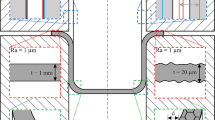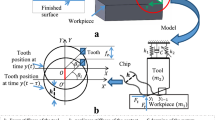Abstract
Geometric-physical modeling and simulation of tool machining processes is an effective realization for manufacturing prediction and verification. By integrating the scheme of CNC code analysis, process planning and optimization, cutting mechanism model, and other related aspects, micro cutting details were implemented to be simulated in advance, detected and monitored in the process, and analyzed afterwards, to achieve the purpose of “Verification IS Production.” Pursuant to this purpose, this paper proposed a research framework of micro geometric modeling and physical simulation for machine tool cutting. On the basis of continuous improvements in 3D modules for cutting geometry simulation, the physical simulation research and verification was carried out with several typical scenes, in which the mappings between real occasions and simulation system were established. With the cutting physical models, this paper deeply investigated the simulation calculation and correction for various factors affecting the cutting performance and indicators and finally verifies, analyzes, and optimizes them through actual machining environments. The purpose of this paper is to explore a feasible and novel way for richer scenes and further research through the multi-element modeling of several comprehensive cutting cases and in-depth micro geometry and physics investigation.












Similar content being viewed by others

Data availability
Not applicable.
Code availability
Not applicable.
References
Liang F, Xie Z, Xia A, Zhou M (2020) Aeroelastic simulation of the first 1.5-stage aeroengine fan at rotating stall. Chinese J Aeronaut 33(2):529–549
Karunakaran K, Shringi R (2008) A solid model-based off-line adaptive controller for feed rate scheduling for milling process. J Mater Process Tech 204(1–3):384–396
Ma H, Liu W, Zhou X, Niu Q, Kong C (2020) An effective and automatic approach for parameters optimization of complex end milling process based on virtual machining. J Intell Manuf 31:967–984
El-Mounayri H, Deng H (2010) A generic and innovative approach for integrated simulation and optimisation of end milling using solid modeling and neural network. Int J Comput Integ M 23(1):40–60
Chaube A, Benyoucef L, Tiwari M (2010) An adapted NSGA-2 algorithm based dynamic process plan generation for a reconfigurable manufacturing system. J Intell Manuf 23(4):1141–1155
Touzout F, Benyoucef L (2018) Multi-objective sustainable process plan generation in a reconfigurable manufacturing environment: exact and adapted evolutionary approaches. Int J Prod Res 57(8):2531–2547
Dai X, Wei Z, Quan Q (2016) Modeling and simulation of bow wave effect in probe and drogue aerial refueling. Chinese J Aeronaut 29(2):448–461
Spence A, Altintas Y (1994) A solid modeller based milling process simulation and planning system. J Manuf Sci E-T Asme 116(1):61–69
Mounayri H, Spence A, Elbestawi M (1998) Milling process simulation - a generic solid modeller based paradigm. J Manuf Sci E-T Asme 120(2):213–221
Miao Y (2016) Research on NC machining simulation based on STL model and its key technologies. Dissertation, Zhejiang University, pp 45–47
Yoshimi T, Masafumi S, Abe Y, Orita R, Sata T (1989) Development of a personal CAD/CAM system for mold manufacture based on solid modeling techniques. CIRP Ann 38(1):429–432
Joy J, Feng H (2017) Frame-sliced voxel representation: an accurate and memory-efficient modeling method for workpiece geometry in machining simulation. Comput Aided Design 88(7):1–13
Yau H, Tsou L (2009) Efficient NC simulation for multi-axis solid machining with a universal APT cutter. J Inf Sci Eng 9(2):134–143
Sullivan A, Erdim H, Perry R, Frisken S (2012) High accuracy NC milling simulation using composite adaptively sampled distance fields. Comput Aided Design 44(6):522–536
Arrazola PJ, Özel T, Umbrello D (2013) Recent advances in modeling of metal machining processes. CIRP Ann 62(2):695–718
Budak E, Altintas Y, Armarego E (1996) Prediction of milling force coefficients from orthogonal cutting data. J Manuf Sci E-T Asme 118(2):216–224
Boz Y, Erdim H, Lazoglu I (2015) A comparison of solid model and three-orthogonal dexelfield methods for cutter-workpiece engagement calculations in three- and five-axis virtual milling. Int J Adv Manuf Tech 81(5–8):811–823
Ferry W, Yip-Hoi D (2008) Cutter-workpiece engagement calculations by parallel slicing for five-axis flank milling of jet engine impellers. J Manuf Sci E-T Asme 130(5):51–63
Palanisamy P, Rajendran I, Shanmugasundaram S (2006) Optimization of machining parameters using genetic algorithm and experimental validation for end-milling operations. Int J Adv Manuf Tech 32(7–8):644–655
Lu K, Jing M, Zhang X, Dong G (2013) An effective optimization algorithm for multipass turning of flexible workpieces. J Intell Manuf 26(4):831–840
Alajmi M, Alfares F, Alfares M (2017) Selection of optimal conditions in the surface grinding process using the quantum based optimisation method. J Intell Manuf 30(3):1469–1481
Çiçek A, Kıvak T, Ekici E (2013) Optimization of drilling parameters using Taguchi technique and response surface methodology (RSM) in drilling of AISI 304 steel with cryogenically treated HSS drills. J Intell Manuf 26(2):295–305
Kurt M, Bagci E (2011) Feedrate optimisation/scheduling on sculptured surface machining: a comprehensive review, applications and future directions. Int J Adv Manuf Tech 55(9–12):1037–1067
Yusup N, Zain A, Hashim S (2012) Evolutionary techniques in optimizing machining parameters: review and recent applications (2007–2011). Expert Syst Appl 39(10):9909–9927
Tandon V, El-Mounayri H, Kishawy H (2002) NC end milling optimization using evolutionary computation. Int J Mach Tool Manu 42(5):595–605
Bharathi RS, Baskar N (2012) Application of particle swarm optimization technique for achieving desired milled surface roughness in minimum machining time. Expert Syst Appl 39(5):5982–5989
Yusup N, Sarkheyli A, Zain A (2013) Estimation of optimal machining control parameters using artificial bee colony. J Intell Manuf 25(6):1463–1472
Li L, Liu F, Chen B, Li C (2013) Multi-objective optimization of cutting parameters in sculptured parts machining based on neural network. J Intell Manuf 26(5):891–898
Altintas Y (2012) Manufacturing automation: metal cutting mechanics, machine tool vibrations, and CNC design. Cambridge University Press
Funding
This research was supported by the National Key R&D Projects No. Y2019-VII-0018.
Author information
Authors and Affiliations
Corresponding author
Ethics declarations
Ethics approval
There are no ethical problems as this research belongs to the field of engineering technology and does not involve any human body-related data.
Consent to participate
All authors consent to participate.
Competing interests
The authors declare no competing interests.
Additional information
Publisher's Note
Springer Nature remains neutral with regard to jurisdictional claims in published maps and institutional affiliations.
Rights and permissions
Springer Nature or its licensor (e.g. a society or other partner) holds exclusive rights to this article under a publishing agreement with the author(s) or other rightsholder(s); author self-archiving of the accepted manuscript version of this article is solely governed by the terms of such publishing agreement and applicable law.
About this article
Cite this article
Liu, W., Ma, H., Zhou, X. et al. A study on multi-factor geometry-physical modeling and simulation in machine tool cutting processes. Int J Adv Manuf Technol 129, 2491–2505 (2023). https://doi.org/10.1007/s00170-023-12490-y
Received:
Accepted:
Published:
Issue Date:
DOI: https://doi.org/10.1007/s00170-023-12490-y



